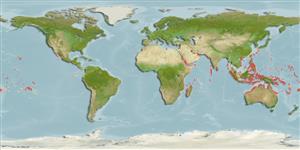Environment: milieu / climate zone / distribuzione batimetrica / distribution range
Ecologia
marino associati a barriera corallina; distribuzione batimetrica 0 - 3 m (Ref. 86942). Tropical; 32°N - 24°S
Indo-Pacific: Red Sea to the Marshall Islands, north to southern Japan, south to the southern Great Barrier Reef and New Caledonia; throughout Micronesia.
Size / Peso / Age
Maturità: Lm ? range ? - ? cm
Max length : 40.0 cm SL maschio/sesso non determinato; (Ref. 1602); common length : 20.0 cm SL maschio/sesso non determinato; (Ref. 9812)
Spine dorsali (totale) : 4; Raggi dorsali molli (totale) : 9 - 10; Spine anali: 3; Raggi anali molli: 9. Olive dorsally; silvery ventrally (Ref. 9812).
Body shape (shape guide): fusiform / normal; Cross section: oval.
Occur in coastal waters, mainly in reef flats and shallow lagoon reefs; often in silty habitats Form schools at the surface (Ref. 9710, 48637). Usually swimming in surface waters near freshwater run-offs. Oviparous, eggs are pelagic and non-adhesive (Ref. 205). Used as live bait in pole-and-line tuna fishing (Ref. 9812).
Life cycle and mating behavior
Maturità | Riproduzione | Deposizione | Uova | Fecundity | Larve
Myers, R.F., 1991. Micronesian reef fishes. Second Ed. Coral Graphics, Barrigada, Guam. 298 p. (Ref. 1602)
IUCN Red List Status (Ref. 130435: Version 2024-2)
Threat to humans
Harmless
Human uses
Pesca: di nessun interesse; esca: usually
Strumenti
Special reports
Download XML
Fonti Internet
Estimates based on models
Preferred temperature (Fonte Biblio.
123201): 25.2 - 29.3, mean 28.5 °C (based on 2805 cells).
Phylogenetic diversity index (Fonte Biblio.
82804): PD
50 = 1.0000 [Uniqueness, from 0.5 = low to 2.0 = high].
Bayesian length-weight: a=0.00977 (0.00595 - 0.01605), b=2.89 (2.75 - 3.03), in cm total length, based on LWR estimates for this species & (Sub)family-body (Ref.
93245).
Trophic level (Fonte Biblio.
69278): 2.4 ±0.2 se; based on size and trophs of closest relatives
Resilienza (Fonte Biblio.
120179): Medio, tempo minimo di raddoppiamento della popolazione 1.4 - 4.4 anni (Preliminary K or Fecundity.).
Fishing Vulnerability (Ref.
59153): Moderate vulnerability (39 of 100).
🛈
Nutrients (Ref.
124155): Calcium = 63.8 [25.1, 220.1] mg/100g; Iron = 0.664 [0.291, 1.741] mg/100g; Protein = 18.6 [16.6, 20.4] %; Omega3 = 0.136 [0.063, 0.299] g/100g; Selenium = 21 [10, 53] μg/100g; VitaminA = 74.7 [14.1, 323.0] μg/100g; Zinc = 1.81 [1.14, 2.76] mg/100g (wet weight);
